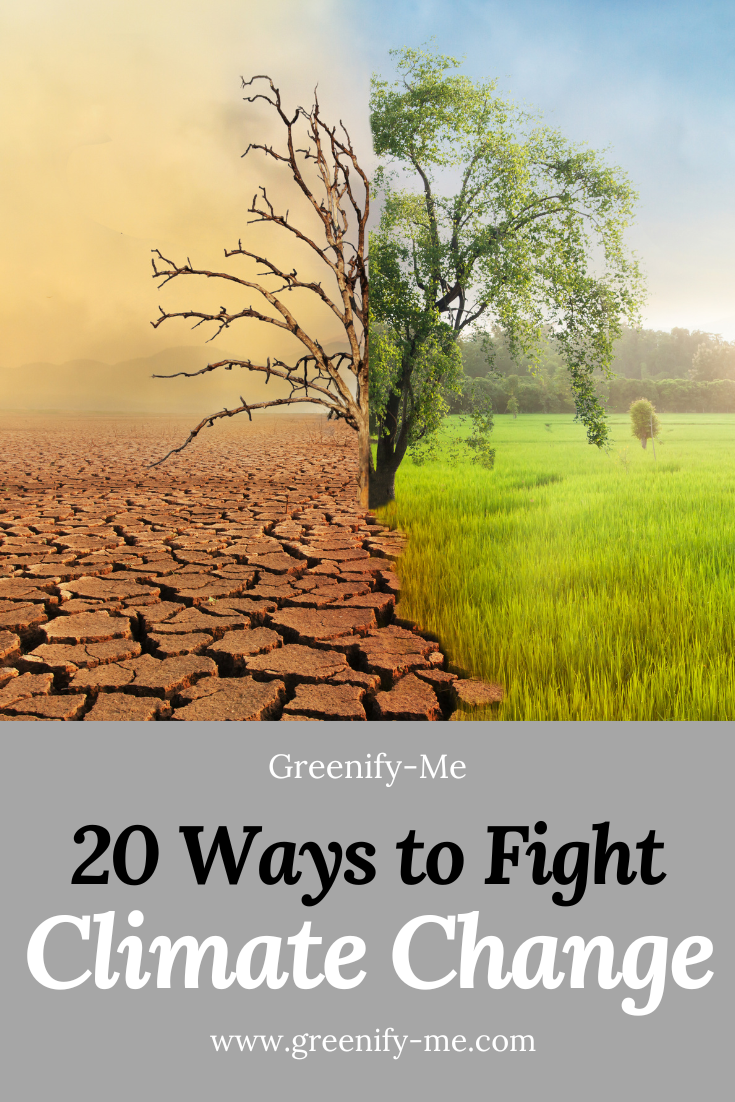Climate change is a huge issue to tackle. Sometimes, our actions don’t feel like enough in the grand scheme of things to fight climate change. But you cannot give in to climate doomism. While there’s only so much one person can do, we need you doing ALL you can do. Everyone can play a part, big or small, in helping our planet. And of course, you should also know it’s not up to one person to fix the climate crisis. We’re in this together, after all. So don’t beat yourself up. Remember: Just 100 companies are responsible for 71% of global emissions. The fossil fuel and petrochemical industries are the main ones responsible for the climate crisis, and we need to hold them accountable – always. I’m a big believer both individual and collective action are equally important. So here are 20 ways to fight climate change and make a positive impact.
20 Ways to Fight Climate Change

Stay informed + get involved
- Follow climate related news. It’s important to stay up to date with what’s going on. I recommend Grist, National Geographic, Nasa, and The New York Times – they always deliver the latest climate news in super informative, well-researched articles. SierraClub, NRDC, NowThisEarth and FutureEarth are great Instagram resources as well for climate related news.
- Attend climate protests around the world. If you’re able to, this is a great way to voice your concerns. Look for any happening near you.
- Advocate for better public transport in your area. We need to rely less on cars and create more walkable and bikeable cities. These kind of cities are more accessible for everyone, and they help reduce carbon emissions. Many BIPOC communities are the ones that the most lack of cycling infrastructure and access to bike shops and services. We need to change this!
- Get involved in local climate policy. Research local issues plaguing your community. Is there too much pollution in your community? No green spaces? Lack of composting? Want a bill passed? Get involved and get vocal about it. Talk to your neighbors, start petitions, and call your reps. Here’s a handy resource to help you find your local reps – just enter your zip code and all their information will load up.
- Learn about local environmental non-profits. Is there a way you can donate to their cause or volunteer your time with them? What about local tree-planting, invasive species monitoring or wildlife rehab?
Make individual changes
6. Divest from fossil fuels by switching banks. Most banks fund the climate crisis by supporting the fossil fuel industry. Chase is one of those banks, but there are many others. Consider switching to banks like Ando or Aspiration, which invest in green initiatives.
7. Subscribe to Greenify-Me’s newsletter. Shameless plug, but you’ll get the latest zero waste, climate positive news delivered right to your inbox.
8. Go plastic-free, when possible. Plastic is made using fossil fuels and is only recycled 5-6% of the time and has a huge carbon footprint in all stages of life (extraction right down to end-of-life). Whenever you can, choose to ditch single-use plastic items in favor of reusables. Check out some of my favorite zero waste essentials.
9. Have Meatless Mondays. Or at least reduce your meat and dairy consumption as a whole. Going vegan is great, but not accessible or realistic for everyone, so be kind to those who cannot.
10. Talk about the climate crisis. We can fight climate change by getting the conversation started. If people don’t know about greenhouse gases, and how they hurt the environment, how can they get involved?
Hold big polluters accountable
11. Call out fast fashion. According to the EPA, 17 million tons of textile municipal solid waste was generated in 2018 alone. And the fashion industry is responsible for water pollution, unethical labor practices, and [umping out cheap garments that don’t last. Support slow fashion brands like Rent In The Loop, or For___Days. Hit up thrift stores, ask for hand-me-downs, host clothing swaps with friends, and shop your own closet first. And make sure to put the pressure on big fashion brands to do better for planet + people (you can try blowing up their IG or twitter accounts).
12. Confront brands about their ingredients + packaging. Notice a brand you love is super wasteful or has terrible ingredients? Here’s how to contact them about it.
13. Call out big oil. Exxon Mobil knew about climate change 40 years ago. They knew their business would harm earth and still spent billions to spread misinformation. Consider joining the Hot Take duo in “greentrolling” fossil fuel companies.
14. Be aware of petrochemicals. This is the next big oil. Petrochemicals are the chemical products obtained from petroleum by refining. Cancer Alley in Louisiana has more than 150 petrochemical plants located near low-income and BIPOC neighborhoods. These pollute the air, water, ground soil and can cause cancer along with other serious illness and disease. Lets speak up about these issues and put them on the radar – these petrochemical plants shouldn’t go under the radar any longer.
15. Get vocal about climate injustices. Many times BIPOC and low-income communities face the worst environmental injustice possible. Unfortunately, big polluters will build right in their backyard (fracking, petrochemical plants, landfills) before white, rich people because they know they can get away with it. This is unacceptable – and it even happens with green energy. Many renewable energy projects are built around indigenous communities without their consent or proper compensation. While we must push forward with renewables, we mustn’t do it at the expense of indigenous people’s safety.
From farm to table
16. Choose local, pesticide-free produce whenever possible. This has a much smaller carbon footprint than produce shipped from overseas, or even across the country. When I say local, I mean within your state, or a neighboring state. Not only will the taste amaze you, it will also be packed with additional nutrients! You can find food like this at your local farmers market.
17. Support organic. If you have a farmers market or grocery store that offers organic options, take it. This will ensure your food was grown without pesticides and fertilizers that harm the soil (and you).
18. Get plastic-free food. If nothing else, try choosing package-free food. Some grocery stores have this option. You can bring your own reusable produce bags with you to eliminate waste.
19. Grow a (community) garden. This is the lowest carbon footprint way to eat! What’s better than walking into your backyard and grabbing dinner? If you’re like me, and have limited space, try joining a CSA or a community garden. No community gardens around? Consider starting your own! After all, everyone should have access to fresh food.
20. Stop getting cut flowers + grow your own. Most florists grow their flowers overseas, which has a huge carbon footprint and they typically use pesticides. Plus, florists tend to use floral foams and a lot of plastic to wrap their blooms. Instead, try supporting organic + sustainable florists. Or, skip the florists altogether and grow your own flowers in your backyard or windowsill. I recommend growing from seed.

So, what did you think of these ways to fight climate change? Let me know your strategies in the comments below.
Enjoyed this post? Be sure to share it! If you like my content, sign up for my newsletter to get notified every time I write a new blog post. To support me even further, please consider buying me a cup of tea to help support my blog.

